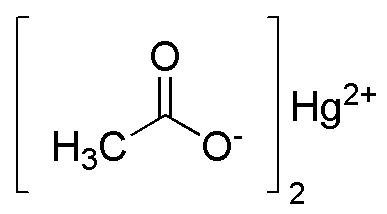Mercury(II) acetate is widely utilized in research focused on:
- Organic Synthesis: It serves as a reagent in various organic reactions, particularly in the synthesis of acetylated compounds, enhancing the efficiency of chemical transformations.
- Catalysis: This compound acts as a catalyst in several chemical processes, improving reaction rates and yields in the production of fine chemicals and pharmaceuticals.
- Analytical Chemistry: Mercury(II) acetate is used in analytical methods for detecting and quantifying certain compounds, providing precise measurements in laboratory settings.
- Biochemical Research: It plays a role in studying enzyme activities and protein interactions, offering insights into biochemical pathways and mechanisms.
- Material Science: This chemical is applied in the development of specialized materials, such as coatings and polymers, where its unique properties can enhance performance.
General Information
Properties
Safety and Regulations
Applications
Mercury(II) acetate is widely utilized in research focused on:
- Organic Synthesis: It serves as a reagent in various organic reactions, particularly in the synthesis of acetylated compounds, enhancing the efficiency of chemical transformations.
- Catalysis: This compound acts as a catalyst in several chemical processes, improving reaction rates and yields in the production of fine chemicals and pharmaceuticals.
- Analytical Chemistry: Mercury(II) acetate is used in analytical methods for detecting and quantifying certain compounds, providing precise measurements in laboratory settings.
- Biochemical Research: It plays a role in studying enzyme activities and protein interactions, offering insights into biochemical pathways and mechanisms.
- Material Science: This chemical is applied in the development of specialized materials, such as coatings and polymers, where its unique properties can enhance performance.
Documents
Safety Data Sheets (SDS)
The SDS provides comprehensive safety information on handling, storage, and disposal of the product.
Product Specification (PS)
The PS provides a comprehensive breakdown of the product’s properties, including chemical composition, physical state, purity, and storage requirements. It also details acceptable quality ranges and the product's intended applications.
Certificates of Analysis (COA)
Search for Certificates of Analysis (COA) by entering the products Lot Number. Lot and Batch Numbers can be found on a product’s label following the words ‘Lot’ or ‘Batch’.
*Catalog Number
*Lot Number
Certificates Of Origin (COO)
This COO confirms the country where the product was manufactured, and also details the materials and components used in it and whether it is derived from natural, synthetic, or other specific sources. This certificate may be required for customs, trade, and regulatory compliance.
*Catalog Number
*Lot Number
Safety Data Sheets (SDS)
The SDS provides comprehensive safety information on handling, storage, and disposal of the product.
DownloadProduct Specification (PS)
The PS provides a comprehensive breakdown of the product’s properties, including chemical composition, physical state, purity, and storage requirements. It also details acceptable quality ranges and the product's intended applications.
DownloadCertificates of Analysis (COA)
Search for Certificates of Analysis (COA) by entering the products Lot Number. Lot and Batch Numbers can be found on a product’s label following the words ‘Lot’ or ‘Batch’.
*Catalog Number
*Lot Number
Certificates Of Origin (COO)
This COO confirms the country where the product was manufactured, and also details the materials and components used in it and whether it is derived from natural, synthetic, or other specific sources. This certificate may be required for customs, trade, and regulatory compliance.


